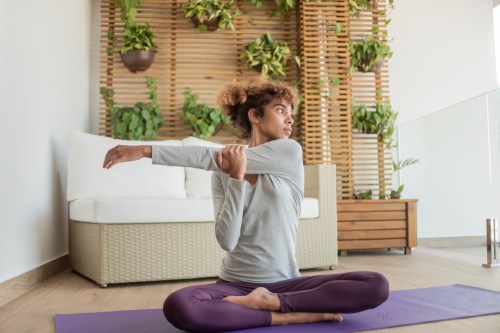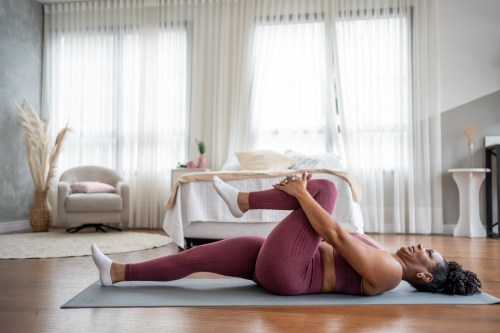Our editors independently select these products. Making a purchase through our links may earn Well+Good a commission
If You Absolutely Must Work From Your Bed, Posture Pros Say This Is a Must-Read
Now that WFH is the norm, working in bed can feel pretty irrisistible. Here's how pros say to do it in a way that's kind to your spine and posture.

The first thing I did when the Well+Good offices closed back in March was order a desk. I spent hours putting together a cozy WFH space in the corner of my bedroom (complete with photos of my dog), then promptly flopped down on my bed, opened my laptop, and forgot the desk even existed.
Experts in This Article
Spokane, WA-based chiropractic physician and author of Eight Minutes to Ageless
Tami Bulmash is a posture pro who specializes in the Alexander Technique, a process that helps to retrain habitual patterns of movement and posture.
While any chiropractor, physical therapist, or posture specialist will tell you that working from bed is not a good idea (in fact, they rank it as one of the worst possible places you can park yourself for hours on end), it’s pretty hard to resist the allure of spending your day lounging on top of a plush pillow top. Plus, for anyone without a dedicated workspace, it may be the only option.
Before you take your next Zoom meeting snuggled up with your duvet, there are a few things pros want you to know about why you should maybe think twice about doing it. “When you’re working from the bed, it doesn’t offer the same kind of support that a harder surface, like a wooden chair, would offer, so you sink into it,” says Tami Bulmash, a posture pro. “The further you sink into the softer surface, the less feedback you have about how you’re managing your body.” This feedback, she explains, gives you the tools you need to understand what your spine is doing, so you can tell when you start to slouch, tense up, or curve forward. Because of this, you’re more likely to feel aches and pains from spending time sitting on a mattress—meaning that the comfort it offers in the short term tends to be misleading.
But if you, like me, are strictly #teambed (despite what literally every expert says), there are a few things you can do to make your go-to workspace slightly kinder on your body.
1. Firm up your mattress
When it comes to working from a mattress, the general rule is “the firmer, the better,” since softer surfaces offer less support. If you don’t want to swap out your pillow top for something more solid, Bulmash suggests putting a piece of plywood on top (which is uncomfortable, but effective). “If you can create a flatter, harder surface, then that would at least be giving your body more feedback and more support,” she explains.
2. Adjust your sitting position
While leaning up against your throw pillows may be comfortable, it’s certainly not the best position for your body in the longterm. “If you can sit criss-cross applesauce, place a small pillow below your low back and snuggle up against the backboard,” says Kelli Pearson, DC, a chiropractic physician. “When we sit, we should be able to keep a mild forward curve in the lowest part of the lumbar spine, and when we sit with our legs straight out in front of us in bed, that healthy curve is completely removed, putting the discs at great risk for being irritated.”
Crossing your legs and giving your back some support will help mitigate the problem. If that’s not an option, you can keep your legs straight, but place a small pillow under your knees to take some of the slack out of your hamstrings. You can also try lying on your stomach with your laptop out in front of you, which can offer your spine some relief.
3. Pile on the pillows
In addition to firming up what’s under your body (by way of your mattress), you’ll also want to give yourself enough back support. Be sure to place some steady pillows—or even a partner-style pillow—behind your back so that you have something solid to lean on.
4. Get up and move around
It’s never a good idea to stay seated for hours on end, and if you’re working from your bed it’s extra important to get up and move around every 30 minutes. Aside from taking a walk around the block (or at the very least, the house), Bulmash also recommends spending 15 to 20 minutes a day lying flat on the floor with a book under your head to allow your spine to reset, and counteract some of the negative effects your bed working has had on your posture. You can also break to sit on a stool or coffee table (or any other surface that doesn’t have back support) to work your core strength.
5. Invest in a bed desk
The worst possible way to sit, according to Bulmash, is with your body in a C-shape rounded over your laptop. To combat this, try bringing a bed desk—like this one, which you can get on Amazon—into the mix, which will allow you to raise your computer to eye level and cross your legs underneath it so that your back is straight.
Need a little extra stretch after all those hours in bed? Follow along with the video below.
Oh hi! You look like someone who loves free workouts, discounts for cult-fave wellness brands, and exclusive Well+Good content. Sign up for Well+, our online community of wellness insiders, and unlock your rewards instantly.
Sign Up for Our Daily Newsletter
Get all the latest in wellness, trends, food, fitness, beauty, and more delivered right to your inbox.
Got it, you've been added to our email list.










